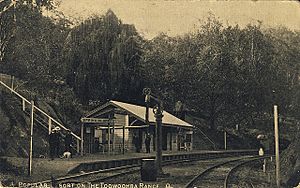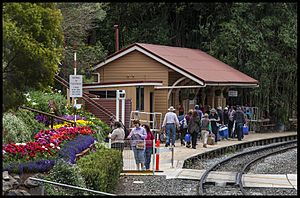Main Range Railway facts for kids
Quick facts for kids Main Range Railway |
|
|---|---|

Tunnel #2 down, Main Range Railway, 2008
|
|
| Location | Railway Corridor from the end of Murphy's Creek Station to Ruthven Street overbridge, Harlaxton, Murphys Creek, Queensland, Australia |
| Design period | 1840s - 1860s (mid-19th century) |
| Built | 1865-1867 |
| Official name: Main Range Railway | |
| Type | state heritage (built) |
| Designated | 5 February 2009 |
| Reference no. | 601480 |
| Significant period | 1865-1867 establishment period |
| Significant components | views from, railway station, pavilion, embankment - railway, quarry, shed - storage, waiting room, formation - railway, building foundations/ruins, trees/plantings, platform, wall/s - retaining, culvert - railway, residential accommodation - workers' housing, abutments - railway bridge, railway, bridge/viaduct - railway, signal box/signal cabin/switch house/mechanical points (rail), garden/grounds, tunnel - railway, signals, cutting - railway, drainage, machinery/plant/equipment - transport - rail |
| Builders | Peto, Brassey and Betts |
| Lua error in Module:Location_map at line 420: attempt to index field 'wikibase' (a nil value). | |
The Main Range Railway is a special heritage-listed railway line in Queensland, Australia. It runs from Murphys Creek to Harlaxton, near Toowoomba. This railway was built between 1865 and 1867 by famous railway builders called Peto, Brassey and Betts. It's a very important part of Queensland's history and is listed on the Queensland Heritage Register.
Contents
Main Range Railway: A Historic Journey
Building Queensland's First Mountain Railway
The Main Range Railway was built between 1865 and 1867. It was a huge project for the Queensland government. The railway connected Murphys Creek to Harlaxton, which is on the edge of Toowoomba.
Overcoming the Great Dividing Range
The Main Range is a big mountain range. It was a tough barrier for trade in the 1840s. Farmers on the Darling Downs needed to get their wool to ports like Brisbane and Ipswich. They also needed supplies brought in. Old cart paths, called dray routes, were hard to use.
By the 1860s, Toowoomba was a main town. Powerful farmers in the Darling Downs wanted a railway. This is why Queensland decided to build its first railway from Ipswich.
The Narrow Gauge Advantage
At first, a company tried to build a horse-drawn tramway. But they couldn't raise enough money. So, the Queensland Government took over. In 1863, they decided to build a railway.
An engineer named Abraham Fitzgibbon suggested a special kind of railway. It would be a "light railway" with a narrow track, called a 3 ft 6 in narrow gauge. This was about 1067 millimeters wide. A narrow gauge allowed for tighter curves on the steep Main Range. It also made building the railway cheaper. This railway was the first long main line in the world to use a narrow gauge!
Hard Work and Clever Engineers
Fitzgibbon became the chief engineer. He planned the line and oversaw the building. The railway from Ipswich to Toowoomba was built in five sections. The Main Range part, called Section 5, was the hardest. It had very steep slopes, nine tunnels, and many bridges.
Building this section needed a lot of skilled workers. The government even advertised in Great Britain and Germany for railway builders. They offered free travel to workers like excavators and bricklayers. In April 1866, over 1000 workers were busy on Section 5.
Robert Ballard was the Engineer-In-Charge for the Main Range. He was an expert in building tunnels. His high-quality work made this section strong and less costly to maintain. Building the railway was dangerous. Workers used picks, shovels, and explosives. Horses and bullocks helped move earth. There were injuries and even deaths during construction.
The Main Range Railway took just over two years to finish. It was a huge project for Queensland. The first train reached Toowoomba on April 12, 1867. The official opening was on April 30, 1867. The railway quickly became the main way to move goods and people.
Amazing Tunnels and Bridges
The Main Range Railway has many cool features. It winds its way up the mountain, with tunnels, cuttings, and bridges. The views of the hills and valleys are amazing.
Tunnels: A Look Inside
There are nine tunnels on the Main Range Railway. They cut through hills of different sizes. Each tunnel has an oval-shaped entrance and is lined with stone and brick. Outside the tunnels, there are steep cuttings with stone walls.
- Tunnel 1 is about 65 meters long and straight.
- Tunnel 2 is about 80 meters long and straight.
- Tunnel 3 is about 62 meters long and curved.
- Tunnel 4 is about 161 meters long and has straight and curved parts.
- Tunnel 5 is about 92 meters long and curved.
- Tunnel 6 is about 87 meters long and curved.
- Tunnel 7 is about 59 meters long and has straight and curved parts.
- Tunnel 8 is about 153 meters long and has straight and curved parts. It also has a special "side gallery." This is a small tunnel that helped workers dig the main tunnel faster. It's the only one like it in Australia!
- Tunnel 9 is about 127 meters long and straight.
These tunnels are some of the oldest railway tunnels in Australia.
Bridges: Crossing Gaps
The railway also has several bridges.
- Murphy's Creek Bridge is a large concrete bridge. It crosses Murphy's Creek.
- King's Bridge is a timber bridge. It goes over Kherim Road.
- Swansons Rail Bridge is near the top of the range. It's special because it was the first concrete arched railway bridge built in Australia! It's about 99 feet long.
- Ruthven Street overbridge (also called Picnic Bridge) is at the very top of the range. It's a metal bridge supported by brick walls. These brick walls are thought to be the oldest surviving ones of their kind in Queensland.
Over the years, many of the original timber bridges were replaced.
Spring Bluff: A Beautiful Railway Stop
Spring Bluff railway station is a very special place on the Main Range Railway. It's about halfway up the mountain. It has a natural spring for water and a flat section of track. Spring Bluff was always the main stop between Murphy's Creek and Toowoomba.
The Station Building and Its Secrets
The Spring Bluff Station building is made of timber. It has a platform, railway houses, and a pavilion. Inside the station building, there are different rooms. There's a ladies waiting room, a shelter shed, an office, and a room for electric staff instruments. These instruments were used to safely manage trains on the line. No train could move without a special "staff" from the station master.
Next to the station building is a signal cabin. It used to have a 15-lever frame to control the tracks.
Homes for Railway Workers
High up on the hillside behind the station are three timber buildings. These were once homes for railway workers.
- The Station Master's House is a timber building with a hipped roof.
- The Night Officer's House is a long timber building.
- The Fettler's Quarters is a smaller timber building. Fettlers were workers who maintained the railway tracks.
Gardens and Fun at Spring Bluff
Spring Bluff is famous for its beautiful gardens. There are garden beds with stone walls and a mix of exotic and native plants. A very old London Plane tree, planted in 1870, still stands there.
In the early 1900s, Spring Bluff became a popular place for picnics and fun. Queensland Railways even encouraged staff to beautify stations. Station Master Ralph Kirsop and his wife Lillian made the gardens amazing in the 1930s and 1940s. They won many prizes for their flowers and produce.
Today, the gardens are still cared for. You can find picnic tables and even a cricket pitch. There's also an old railway carriage that serves refreshments. During Toowoomba's Carnival of Flowers in September, special train trips run from Toowoomba to Spring Bluff. It's a very popular tourist spot!
Why the Main Range Railway is Special
The Main Range Railway is important for many reasons:
- Queensland's Development: It was a huge project that helped Queensland's economy grow. It connected the inland farming areas to the ports.
- First Mountain Crossing: It was the first railway to cross the Great Dividing Range in Queensland and Australia. It opened even before the famous Zig Zag Railway in New South Wales.
- World First: It's believed to be the world's first main line railway to use a narrow gauge. This was a big technical achievement for the 1860s.
- Rare Tunnels: The tunnels are among Australia's oldest railway tunnels. Tunnel 8, with its side gallery, is especially rare.
- Oldest Bridge Parts: The brick supports of the Ruthven Street overbridge are thought to be the oldest of their kind in Queensland.
- Beautiful Scenery: The railway offers amazing views of the mountains and valleys. The Spring Bluff station, with its gardens, is a very picturesque spot.
- Clever Engineering: Building this railway over such challenging terrain showed incredible engineering skill. It used tight curves, tunnels, and bridges to climb over 365 meters.
The Main Range Railway continues to be a vital transport link today, carrying goods like coal for overseas markets.
Images for kids






